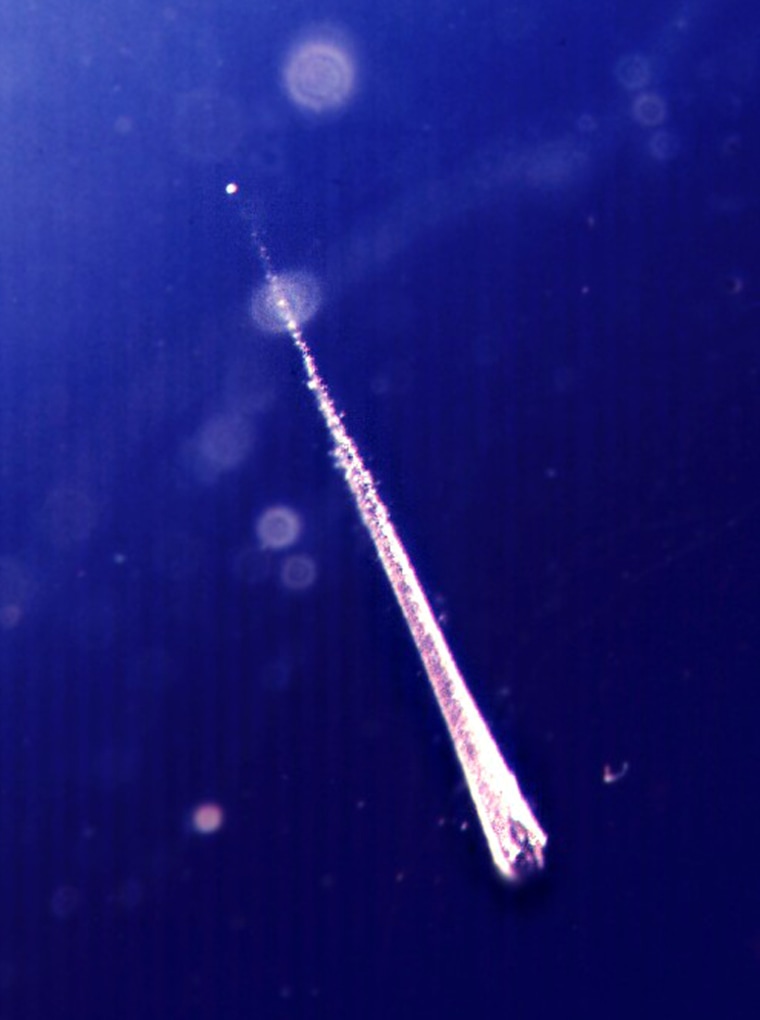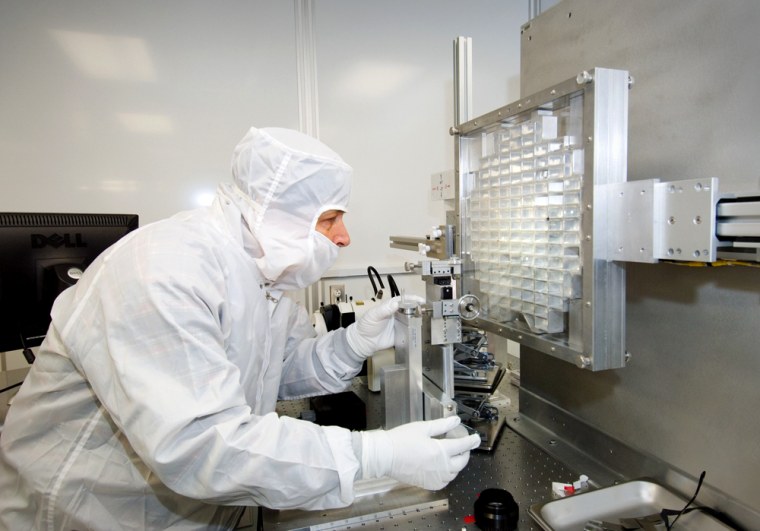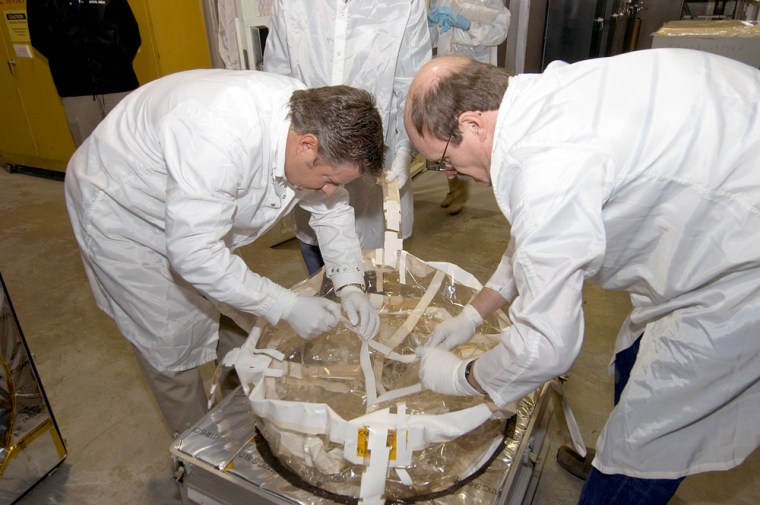Scientists say they are overjoyed by their first look at the comet specks and interstellar dust captured by NASA's Stardust spacecraft during its seven-year mission.
"It exceeds all expectations," the mission's principal investigator, University of Washington astronomer Donald Brownlee, said in a university statement posted Wednesday. "It's a huge success."
The samples were brought from space inside a double-sealed capsule that plunged down to the Utah desert early Sunday. That capsule was flown to a nearby military air base and opened in a temporary clean room, revealing the inner canister within. The canister was shipped to NASA's Johnson Space Center in Houston under a veil of secrecy on Tuesday, traveling first by military transport and then in an unannounced convoy.
The next stop was a special clean-room laboratory at the space center, in the same building were moon rocks were received during the Apollo era. Scientists carefully opened the canister to look at the dust from Comet Wild 2 and interstellar space — fine grains embedded in the grid of ultra-light aerogel that served as the "catcher's mitt" during the Stardust spacecraft's high-speed encounter with the comet.
If anything, the initial processing went better than expected, according to an internal NASA memo obtained by MSNBC.com.
"The canister was opened up, and the aerogel collector grid was removed," the memo reported. "Both the canister and aerogel were in remarkably great shape considering they've been in space for seven years."

The memo said that "hundreds of particles" could be seen in the collector tray for cometary samples. "There were two particularly large comet particles that had 'exploded' inside the aerogel," it reported. "Needless to say, the scientists are ecstatic."
NASA researcher Scott Sandford said the collection effort "succeeded well beyond our wildest hopes."
"I am not sure if it is good clean-room protocol to hug each other, but there was a lot of it going on for the first 10 minutes or so," Sandford said in an e-mail forwarded by NASA's Ames Research Center.
Brownlee said he could see "lots of impacts," signaled by carrot-shaped tracks inside the aerogel. Some of the tracks could be seen from several feet away, with black bits of comet dust at the ends of the tracks. One track "is almost large enough to put your little finger into it," he said.
Brownlee estimated that more than a million specks of dust, ranging down to microscopic size, might be embedded within the aerogel blocks. The internal memo noted that comet-dust trails were found even within stray bits of aerogel that had settled around the inside of the canister.
Scientific treasure trove
The dust specks represent a treasure trove for about 200 scientists from around the world who are waiting to analyze the Stardust samples. Comets are "dirty snowballs," cosmic leftovers from the formation of the solar system 4.6 billion years ago. Therefore, pristine samples of a comet could well shed new light on the chemical origins of life on Earth.
Fast-flying cometary bits were collected on one side of Stardust's tennis-racket-shaped tray of aerogel, as Stardust flew within 150 miles (240 kilometers) of Comet Wild 2's nucleus in January 2004. During an earlier sampling session, in April 2000, Stardust gathered interstellar dust samples on the other side of the tray. That part of the mission succeeded as well, according to the internal memo.
“The interstellar tray had two visible-eye trails observed,” the memo said. “Since the interstellar particles are considerably smaller than the cometary particles, they will require inspection by microscope to properly observe them."
The memo said Stardust's science team wrapped up their initial inspections three hours early.
What's next?
Michael Zolensky, the curator of the cosmic dust at Johnson Space Center, outlined the next steps in the process during a pre-landing interview.
Scientists dressed in the classic "bunny suits" of white coveralls and hats will use microscopes, micro-manipulators and a computer-controlled set of diamond blades to cut the aerogel into thin slices. They'll catalog all the embedded dust particles, and then cut them away for shipment to bigger laboratories around the world.
As researchers study the samples, they'll be looking for organic molecules as well as water molecules and materials from beyond the solar system. Preliminary results will be reported at a special session of the annual Lunar and Planetary Science Conference in Houston in mid-March, Zolensky said.
A public science project called Stardust @ Home is due to start up at about the same time. The project will distribute images of the aerogel samples to Internet users willing to help scientists look for interstellar dust trails. More than 72,000 users pre-registered for the project as of Wednesday.
Solving scientific puzzles
Zolensky said the comet bits and the interstellar dust could solve a puzzle that scientists didn't even know existed when the project began: where Earth’s water originally came from.

“It was calculated that comets had enough water to fill Earth’s oceans,” he explained, and for years that was the leading theory for their origin. But the results from new observational techniques go against that idea: The water from comets appears to have a different chemical signature than the water on Earth.
“This was discovered in the past 10 years, using spectroscopy of starlight observed passing through the coma – it’s changed in subtle ways depending on the isotopes,” Zolensky said. Analyzing the fresh cometary samples will help validate the results from remote sensing.
NASA aircraft have been collecting dust high in Earth’s atmosphere for 20 years, and much of it is probably cometary dust as well. “These new samples will validate these existing collections,” Zolensky explained.
New techniques, new missions
In the 37 years since the first lunar samples arrived, Zolensky explained, analysis technology has advanced so far that scientists could get better results from one grain today than they extracted from the "bulk samples" of rock and soil brought back by astronauts, Zolensky said.
Many of the tests being performed today were not available back in the Apollo era. Fortunately, some of the Apollo moon samples were put into storage to await the invention of just such new technologies.
Zolensky said the $212 million Stardust mission could provide a model for future sample return missions. “It’s not designed for very heavy samples — maybe a few grams at most,” he said. But the technique could well be used to capture atoms of noble gases from comet tails, or even catch samples of gas and dust from the upper atmosphere of Mars.
Meanwhile, the Stardust probe flies on, its return capsule jettisoned but its cameras and other scientific instruments still fully functional. “It has plenty of fuel remaining,” Zolensky said. The potential targets for future flybys — comets, asteroids or even planets — are still under discussion.
NBC News space analyst James Oberg spent 22 years at NASA's Johnson Space Center as a Mission Control operator and an orbital designer.
